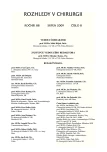Contribution of MRI to the Thoracolumbar Spine Injuries Diagnostics and Therapy
Authors:
L. Hrabálek; M. Houdek; M. Vaverka
Authors‘ workplace:
Neurochirurgická klinika FN a LF UP Olomouc, přednosta: prof. MUDr. M. Houdek, CSc.
Published in:
Rozhl. Chir., 2009, roč. 88, č. 8, s. 461-465.
Category:
Monothematic special - Original
Overview
Aim:
The aim of this study was to assess correlation between the degree of severity of the intervertebral disc injury and the vertebral enoplate injury, evaluated based on MRI, and the resulting final clinical condition and radiological findings.
Material and Methodology:
The authors performed a prospective analysis of patients with thoracolumbar fractures type A1 or A3, without injuries to the nervous system. The study group included 73 subjects (the mean age was 45.52 years), 44 males and 29 females. The type A1fracture group including 31 patients received conservative treatment and the type A3 fracture group including 42 subjects underwent surgery with posterior transpedicular (TP) fixation. After their injury, the patients were examined using plain x-rays, CT and MRI. At month 18 of their follow up, a control MRI examination was performed to assess spinal kyphotization, the spinal body height decrease and the clinical outcomes.
Results:
The data underwent statistical evaluation. The conservative treatment group showed no statistically significant correlation between the severity of the intervertebral disc and vertebral enoplate trauma and the resulting final clinical outcome or radiological findings, however, the conservative treatment of the type A1 fractures failed in 9.3% of the subjects. This was due to the disc trauma and its consecutive replacement resulted in improvement of the clinical condition. Posterior TP fixation in the type A3 fractures did not prevent statistically significant higher rates of kyphotization and reduced weight - bearing tolerance in patients with more severe disc and vertebral enoplate traumas (grade 3 or 4), compared to patients with less severe traumas (grade 2)
Conclusion:
Posttraumatic assessment of the disc and vertebral enoplate trauma severity using MRI is of significance for predicting the fracture healing prognosis, as well as the final clinical outcome of the procedure.
Key words:
trauma – thoracic and lumbar spine – intervertebral disc – MRI – transpedicular fixation
Sources
1. Haba, H., Taneichi, H., Kotani, et al. Diagnostic accuracy of magnetic resonance imaging for detecting posterior ligamentous complex injury associated with thoracic and lumbar fractures. J. Neurosurg. (Spine 1), 2003; 99 : 20–26.
2. Holdsworth, F. W. Fractures, dislocations and fracture dislocations of the spine. J. Bone Joint Surg., 1963; 45B: 6–20.
3. Holdsworth, F. W. Fractures, dislocations and fracture dislocations of the spine. J. Bone Joint Surg., 1970; 52A: 1534–1551.
4. Hrabálek, L., Bučil, J., Vaverka, M., Houdek, M., Krahulík, D., Kalita, O. Úskalí diagnostiky a léčby flekčně-distrakčních poranění hrudní a bederní páteře: prospektivní studie. Cesk. Slov. Neurol. N., 2008; 71/104(2): 163–172.
5. Lee, H. M., Kim, H. S., Kim, D. J., et al. Reliability of magnetic resonance imaging in detecting posterior ligament complex injury in thoracolumbar spinal fractures. Spine, 2000; 25 : 2079–2084.
6. Leferink, V. J. M., Veldhuis, E. F. M., Zimmermann, K. W., et al. Classificational problems in ligamentary distraction type vertebral fractures: 30% of all B-type fractures are initially unrecognised. Eur. Spine J., 2002; 11 : 246–250.
7. Levi, A. D., Hurlbert, R. J., Anderson, P., et al. Neurologic deterioration secondary to unrecognized spinal instability following trauma – a multicenter study. Spine, 2006; 31 : 451–458.
8. Lukáš, R., Suchomel, P., Šrám, J., Endrych L. Klasifikací řízená volba operačního přístupu při operačním léčení zlomenin torakolumbární páteře. Rozhl. Chir., 2006; 85 (7): 365–372.
9. Petersilge, C. A., Parthria, M. N., Emery, S. E., Masaryk, T. J. Thoracolumbar burst fractures: evaluation with MR imaging. Radiology, 1995; 194 : 49–54.
10. Hrabálek, L., Bučil, J., Vaverka, M, Houdek, M, Krahulík, D., Kalita, O. Indikace přední náhrady meziobratlové ploténky u zlomenin hrudní a bederní páteře s využitím magnetické rezonance – prospektivní studie. Cesk. Slov. Neurol. N., 2009; 72/105 (2): 132–140.
11. Oner, F. C, van Gils, A. P., Faber, J. A. J, et al. Some complications of common treatment schemes of thoracolumbar spine fractures can be predicted with magnetic resonance imaging: prospective study of 53 patients with 71 fractures. Spine, 2002; 27 : 629–636.
12. Oner, F. C, van Gils, A. P., Dhert, W. J., et al. MRI findings of thoracolumbar spine fractures: a categorisation based on MRI examinations of 100 fractures. Skeletal Radiol., 1999; 28 : 433–443.
13. Farcy, J. P. C., Weindenbaum, M., Glassmann, S. D. Sagital index in management of thoracolumbar spine fractures. Spine, 1990; 9 : 958–965.
14. Magerl, F., Aebi, M., Gertzbein, S. D., et al. A comprehensive classification of thoracic and lumbar injuries. Eur. Spine J., 1994; 3 : 184–201.
15. Denis, F., Armstrong, G. W. D., Searls, K., et al. Acute thoracolumbar burst fractures in the absence of neurological deficit: A comparison between operative and nonoperative treatment. Clin. Orthop., 1984; 189 : 142.
16. Alenay, A., Acaroglu, E., Yazici, M., et al. Short-segment pedicle instrumentation of thoracolumbar burst fractures. Does transpedicular intracorporeal grafting prevent early failure? Spine, 2001; 26 : 213–217.
17. Cripton, P. A., Jain, G. M., Wittenberg, R. H., at al. Load-sharing characteristics of stabilized lumbar spine segments. Spine, 2000; 25 : 170–179.
18. Adams, M. A., Hutton, W. C. Gradual disc prolapse. Spine, 1985; 10 : 524–531.
19. Adams, M. A., Freeman, B. J. C, Morisson, H. P., et al. Mechanical initiation of intervertebral disc degeneration. Spine, 2000; 25 : 1625–1636.
20. Cinotti, G., Rocca, C. D., Romeo, S., at al. Degenerative changes of porcine interverteral disc induced by vertebral endplate injuries. Spine, 2005; 30 : 174–180.
Labels
Surgery Orthopaedics Trauma surgeryArticle was published in
Perspectives in Surgery

2009 Issue 8
Most read in this issue
- The Operation Risks and the Force of Preoperative Management
- Lesions in the Popliteal Fossa with Neurologic Symptomatology – Case Reports, Diagnostics and Treatment
- Transarterial Chemoembolization in Hepatocellular Carcinoma
- One-Year Survival Outcomes in Patients with Pancreatic Head and Portomesenteric Veins Resection
